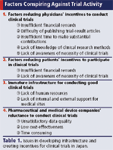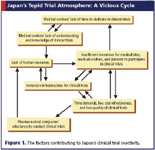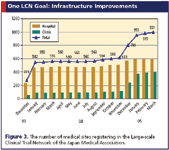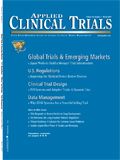Promoting Clinical Trials in Japan
Applied Clinical Trials
Launched in 2003, the LCN Project calls for more studies and an improved trial infrastructure.
Japan is the second largest country in the world in consumption of pharmaceuticals, yet its clinical development activities are not very advanced compared to the United States and other developed countries. In addition, the lack of infrastructure for clinical trials is an especially critical problem for the country.

There are several important factors that contribute to Japan's relative inactivity in clinical trials1 (see Table 1), which will be explored.

Table 1: Factors Conspiring Against Trial Activity
Hindering efforts
From a physician's perspective, several issues reduce their incentive to conduct clinical trials. The first one is unsatisfactory financial advantages. Usually, all the fees involved with conducting a trial are paid to a medical site under a contract between its president and the pharmaceutical company. Although part of the money is paid to the clinicians who participate in the trial, the amount is generally considered insufficient by physicians.
Second, since most clinical trials for drug/medical device approvals in Japan are conducted after equivalent clinical trials in the United States and other countries, trial-related articles are generally not accepted by well-known medical journals.
Third, there are not many clinicians familiar with clinical research methods who have time to spend on trials. This is blamed on the Japanese medical education system, which has long focused on daily practice rather than clinical research.
Similarly, few incentives plus a lack of awareness are credited with limiting patient participation in clinical trials in Japan.
It is hypothesized that Japanese people are less likely to participate in trials because few financial advantages are offered under the national health care system. In the system, all Japanese people are equally provided with health care and covered under either national health insurance or social health insurance. Therefore, patients do not need to consider being subjects in clinical trials for the sake of financial benefit. However, there is no evidence for this hypothesis, and it would not be appropriate if subjects were willing to enroll in trials merely for financial benefit. An alternative view is that there may be a lack of understanding among Japanese people of the necessity of clinical trials.
The infrastructure for clinical trials in Japan is also relatively immature. This problem is due to a lack of human resources, a lack of internal and external support at medical sites, limited means for patient recruitment, and other factors. Because it is difficult for pharmaceutical and medical device companies to obtain satisfactory results, they are reluctant to conduct clinical trials for drug/medical device approval. All of these problems are interrelated and constitute a vicious cycle (Figure 1).

Figure 1: Japans Tepid Trial Atmosphere: A Vicious Cycle
Figure 2 shows the decline in clinical trial applications filed with Japan's Pharmaceuticals and Medical Devices Agency between 1990 and 2002.2

Figure 2: Trial Applications: Trending Downward
Call to action
Given Japan's relative inactivity in clinical trials, the Japanese government, the Ministry of Education, Culture, Sports, Science & Technology, and the Ministry of Health, Labour, and Welfare released a statement in April 2003 called "A Three-Year Plan for the National Revitalization of Clinical Trials."1 In it, major problems with clinical trials in Japan and several future plans for solving them are presented. One of the action plans called for promoting a clinical trial network.
So, in October 2003 the Large-Scale Clinical Trial Network (LCN) Project was launched. An important issue related to the launching of the project was the changing of regulations for conducting clinical trials for drug approval. On 30 July 2003 the Pharmaceuticals Affairs Law was changed so that physicians and dentists could conduct trials for drug approval.
The LCN Project has two main purposes: creating a new nationwide clinical trials network and encouraging physicians, dentists, and related staff to conduct investigator-initiated trials for drug approval. The Japan Medical Association (JMA) has played a leading role in the LCN Project.
The JMA was established in 1916 and includes 47 prefectural medical associations. The mission of the JMA is to promote policies that protect the health of all citizens and to preserve the autonomy of physicians at the national level of health care policy planning. The JMA's impact comes from its high membership rate.
There are advantages to the JMA taking on the LCN Project: It has a nationwide network, outstanding initiatives in place in the Japanese medical field, and academic resources. In August 2004, the JMA established a new division, the Center for Clinical Trials of the JMA (JMACCT), to carry out the LCN Project. JMACCT activities started in October 2004.
JMACCT's mission & budget
The JMACCT has two primary aims:
- The LCN Project: to promptly provide the public with medically necessary or new pharmaceutical products and medical devices; organize multiple medical institutions into a network (i.e., the LCN); and conduct model clinical trials to improve the infrastructure for clinical trials in Japan.
- Promoting the LCN Project: In pursuing the above, to maintain the activities of the JMACCT and the LCN in Japan; to support and oversee clinical trials in cooperation with the LCN; and to conduct other necessary related activities.
The entire budget for LCN Project activities is subsidized by the MHLW as part of its Health and Labour Sciences Research Grants (HLSRG). In most HLSRG-funded projects, personnel costs are somewhat limited. Apparently, HLSRG regulations have led some researchers to reduce the size of their projects. However, for LCN Projects, use of HLSRG has been more flexible and the JMACCT has been able to expense costs for human resources based on the JMA's internal rules. This has made it possible for JMA to recruit specialists in the field, and is one of the advantages of the JMACCT.
Large-scale clinical trial network
Improving the infrastructure for clinical trials at each clinical site is important to encourage clinical trials in Japan. The LCN was created to solve this problem, by helping sites gain clinical trial knowledge and skills, including compliance with GCP standards. The JMACCT provides LCN member institutions with various forms of support, thereby creating an environment conducive to carrying out high-quality clinical trials.
Registration for the LCN may be done either online through JMACCT's Web site ( www.jmacct.med.or.jp) or by submitting a form to the JMACCT by mail (Figure 3 shows the number of medical sites, both hospitals and clinics, recruited between December 2003 and March 2005). The legal definition of a hospital in Japan is an institution with 20 or more beds, and a clinic is an institution with less than 20 beds.

Figure 3: One LCN Goal: Infrastructure Improvements
Investigator-initiated trials
Because investigator-initiated clinical trials (IICTs) for drug and medical device approval are relatively new (July 2003) and it is difficult for physicians to conduct IICTs without systematic help, the JMACCT has been providing assistance.
Procedure for candidate trial product selection. According to the JMACCT view, candidate products should be those likely to be approved as soon as possible so that they may be used in clinical practice in Japan. In other words, prioritized candidates may be new, old, approved or yet-to-be approved, since the focus is on obtaining approval for pharmaceutical products approved overseas but not in Japan—this also applies to other products that have not been permitted for use for their approved indication and are used in off-label ways.
To select candidate trial products, as a first step the JMACCT requested that the Japan Association of Medical Science (JAMS) recommend candidates by passing on the request to its 99 medical specialty societies to ensure that the listed products were necessary and appropriate. Since 2004, the procedure for candidate trial product selection has changed. Now, a candidate drug is not selected by external committee members but by an investigator.
Supporting IICTs. The JMACCT supports IICTs not only financially but also in many other practical ways. The JMACCT consults with investigators on trial protocols, case report forms, informed consent forms, etc. Cooperating with two insurance companies, it also created a new type of insurance for IICTs. Under current GCP requirements, the principal investigator of an IICT is responsible for any damage caused by the trial—just as a manufacturing company is responsible in drug/medical device approval trials. The insurance companies agreed to produce the IICT insurance with the JMACCT's approval because they presumed
that the trials selected by JMACCT would be scientific and ethical.
Standard operating procedures (SOPs) for IICTs is a hurdle for physicians because they do not have the time to develop SOPs on their own. Therefore, the JMACCT developed templates for SOPs, which is posted on their Web site. Reporting serious adverse events (SAEs) to the regulatory agency is another concern for physicians since sufficient time and human resources are required to fulfill this obligation. The JMACCT has been developing a simplified system for its IICTs to make SAE reporting easier for busy physicians.
In February 2005, the JMACCT established a Data Management Division to manage data from clinical trials.
Developing infrastructure
The JMACCT recognizes that there are several challenges to developing better infrastructure for clinical trials in Japan and has been undertaking several activities to resolve them.
To understand problems pertaining to clinical trial development and find solutions, the JMACCT held a symposium on the activation of clinical trials in November 2004 that was attended by representatives from all sectors. The JMACCT invited executive officers from the MHLW and the Pharmaceuticals and Medical Devices Agency (regulatory bodies), the President of the Japan Pharmaceutical Manufacturers Association (pharmaceutical industry), the President of the Japanese Society of Clinical Pharmacology and Therapeutics (academia), a well-known actress with a national license in nursing (the public), and the President of the National Hospital Organization and executives of JMA (physicians).
The lack of awareness among Japanese people about clinical trials is one of the challenges facing clinical trial development. The JMACCT produced two posters to facilitate better understanding and provided them to over 150,000 medical institutions through the JMA network in January 2005. Other efforts include distributing JMACCT newsletters to sites registered with the LCN that contain information about trials.
Conclusion
Developing infrastructure for clinical trials is one of the top priorities of the Japanese government. And the clinical development industry, academics, medical professionals, and the Japanese people expect positive outcomes from the LCN project. While it is true that solving the various problems involved in developing Japan's infrastructure for clinical trials will not be easy, the project represents an important milestone.
The increasing number of sites registering with the LCN, the increasing number of JMACCTs supporting clinical trials for drug approval, and the growing scale of the Data Management Division of the JMACCT are valuable achievements. These types of initial developments are vital for progress toward the government's goal. As it is often said: "The longest journey begins with a single step."
Acknowledgments
The authors would like to thank Ms. Elizabeth Lee-Hood, Mr. Yoshiyuki Sei, and Ms. Mai Goto for their assistance in the preparation of this manuscript.
Takahiro Uchida is a visiting scholar of the division of cardiology, Tokyo Women's Medical University. Fumiaki Kobayashi* is director of regulatory affairs at the Center for Clinical Trials of the Japan Medical Association (JMACCT), 17 Fl. Bunkyo Green Court Center Office, 2-28-8 Honkomagome, Bunkyo-Ku, Tokyo 113-0021, Japan, 81-3-5319-3781, email: fkobayashi@jmacct.med.or.jpKiko Tanaka is director of the data management division at the JMACCT. Hiroshi Mikami is chief executive officer of Higashikori Hospital, and Akira Teraoka is chief executive officer of Teraoka Memorial Hospital.
*To whom all correspondence should be addressed.
References
1. http://www.mhlw.go.jp/shingi/2005/03/dl/s0329-13i.pdf (Japanese), accessible as of 2 September 2005.
2. http://www.nihs.go.jp/pmdec/table2.htm (Japanese), accessible as of 2 September 2005.
3. Kousei Rodou Kagaku Kenkyu-hi no Tebiki (Gyosei, Tokyo, 2004).

Improving Relationships and Diversifying the Site Selection Process
April 17th 2025In this episode of the Applied Clinical Trials Podcast, Liz Beatty, co-founder and chief strategy officer, Inato, discusses a number of topics around site engagement including community-based sites, the role of technology in improving site/sponsor relationships, how increased operational costs are impacting the industry, and more.